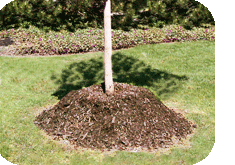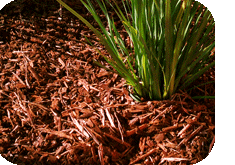
This mailer has been provided as an avenue of dispersing information related to landscape architecture in hopes of fostering greater understanding and collaboration between professions. Topics address issues that affect the built environment within which we live.
Is applying mulch to landscape beds truly beneficial?
"No occupation is so delightful to me as the culture of the earth, no culture comparable to that of the garden ...
But though an old man, I am but a young gardener." Thomas Jefferson
For centuries, farmers and gardeners alike have been adding amendments to the soil in order to increase the production of food, plant materials, flowers and for many other reasons as well. Similarly, it is no secret that mulches, when added to landscape beds, can be beneficial in many ways to plants; however, when they are installed and maintained incorrectly, those benefits are neutralized or lost rather quickly. Perhaps not very widely understood, mulching can be one of the most beneficial or damaging management practices for landscapes. This month's issue highlights the benefits of mulch (some are common knowledge, others are not), the problems associated with inappropriate applications of mulch and recommendations on how to correctly install and manage mulch.
Benefits of Mulch - There are many types of mulch ranging from inert materials such as rock and rubber, to organic materials such as bark, wood chips, nut hulls and straw. Each of these will have benefits and limitations, however, the particulars are not discussed in this issue. The main benefits of applying mulch around landscape plants are: aesthetics, ease of maintenance and plant health. The most important of these benefits being plant health. Mulching alone has been shown to increase fine root densities (the roots collecting nutrients and water) in landscape trees by up to 15%. Some of the many fundamental benefits of mulch, primarily related to plant health include:
• Soil moisture conservation ![]() • Weed growth suppression
• Weed growth suppression![]() • Soil temperature buffering
• Soil temperature buffering![]() • Erosion control
• Erosion control
• Water storage (up to 20x its dry weight)![]() • Soil compaction protection and improved soil aeration
• Soil compaction protection and improved soil aeration
• Soil texture and fertility improvements![]() • Reflective heat and light reduction
• Reflective heat and light reduction ![]() • Protection from mowers and equipment
• Protection from mowers and equipment
 Problems Caused by Improper Mulch Methods- While proper mulching is very beneficial, improper mulching techniques can be very damaging to shrubs and trees. No mulch at all is often better than mismanaged mulch! The application of too little mulch allows weeds to grow, creating not only maintenance issues but also results in competition of resources necessary for plant growth. The inverse of this scenario however, is more damaging. A very common misconception is that "if a little mulch is good, then a lot of mulch is better". It is not uncommon to see mulch volcanoes at the base of shrubs and trees in excess of a foot tall. In many cases this is the origin for plant health decline and often is the cause of plant mortality. Excess mulch becomes an issue for many reasons, a few are listed below:
Problems Caused by Improper Mulch Methods- While proper mulching is very beneficial, improper mulching techniques can be very damaging to shrubs and trees. No mulch at all is often better than mismanaged mulch! The application of too little mulch allows weeds to grow, creating not only maintenance issues but also results in competition of resources necessary for plant growth. The inverse of this scenario however, is more damaging. A very common misconception is that "if a little mulch is good, then a lot of mulch is better". It is not uncommon to see mulch volcanoes at the base of shrubs and trees in excess of a foot tall. In many cases this is the origin for plant health decline and often is the cause of plant mortality. Excess mulch becomes an issue for many reasons, a few are listed below:
- Availability of oxygen and the ability of the plant to exchange gasses with the soil and air are inhibited by excessive mulch.
- Growth of fungi and molds that cause rotting of the roots and trunk flares is common.
- Growth of fungus and molds can result in the production of toxic acids such as ammonia and other alcohols.
- Hydrophobic mulches are common in excessively mulched areas due to fungus growth.
- Deep and constant applications of mulch can alter the surface soil pH to undesired levels.
- Deep applications of mulch create prime habitats for rodent nests within which rodents chew on the bark to access plant sugars.
- Some mulches may contain weed seed.
- Uncomposted mulches can alter carbon/nitrogen ratios in surface soil.
 Mulch Installation Recommendations - Nature is the ultimate example to study for proper mulching technique. Plants in nature mulch the landscape by dropping their leaves and other vegetative matter in thin layers, effectively building a layer of weed control. Natural decomposition breaks down these layers steadily as more material is deposited on top. This cycle is quite effective and by mimicking it many problems associated with mulches can be avoided. Below are just a few of many important mulching recommendations:
Mulch Installation Recommendations - Nature is the ultimate example to study for proper mulching technique. Plants in nature mulch the landscape by dropping their leaves and other vegetative matter in thin layers, effectively building a layer of weed control. Natural decomposition breaks down these layers steadily as more material is deposited on top. This cycle is quite effective and by mimicking it many problems associated with mulches can be avoided. Below are just a few of many important mulching recommendations:
- Choose the type of mulch based on installation location, amount of plant material to be mulched and by plant physiology, rather than design parameters such as aesthetics and maintenance.
- Choose a mulch that will not hinder the exchange of gases and water to the soil below.
- Do not use fresh wood mulch products that have not been composted for long enough to partially neutralize carbon/nitrogen ratios.
- Know the soil type. Apply less mulch on soils with poor drainage and more on soils with good drainage. (clay soils with very poor drainage may only need 2" (for adequate weed control) or less if other weed control measures are in place. Sandy soils may need 3-4 inches)
- Keep mulch away from the trunks and stems of shrubs and trees. (no mulch volcanoes!)
- Mulch to the driplines of shrubs and trees if possible.
- Rake mulches regularly to prevent matting and hydrophobic conditions.
- Use mulches certified free of weed seed.
Prior Issues of Interest
- Nature Series: Nature Deficit Disorder
- Nature Series: The Healing Power of Nature
- Nature Series: Infusing Nature into Play
- The Parks and Rec Budget Reduction Trend
- Artificial Landscape Water Cycles
The next time you need a Landscape Architect on your project, consider O'Dell Engineering's Landscape Architecture Department.
Services include:
- Park and Playground Design
- Recreational Facility Design
- Site Planning
- Streetscape Design
- Urban Design
- Commercial Design
- Model / Production Homes
- 3-D Visualizations
- Graphic Design
- Arboriculture Consulting
- Playground Inspection
References:
1-Carlson, Chris R. "Mulch, Part 1: Too much of a good thing can be bad." Plant Health Care. 2003. 31-36
2-Carlson, Chris R. "Mulch, Part 2: Go wide, not deep." Plant Health Care. 2003. 37-41

Author: Chad Kennedy, Landscape Architect
This informational article provided by O'Dell Engineering - 1165 Scenic Drive, Suite A, Modesto CA 95350